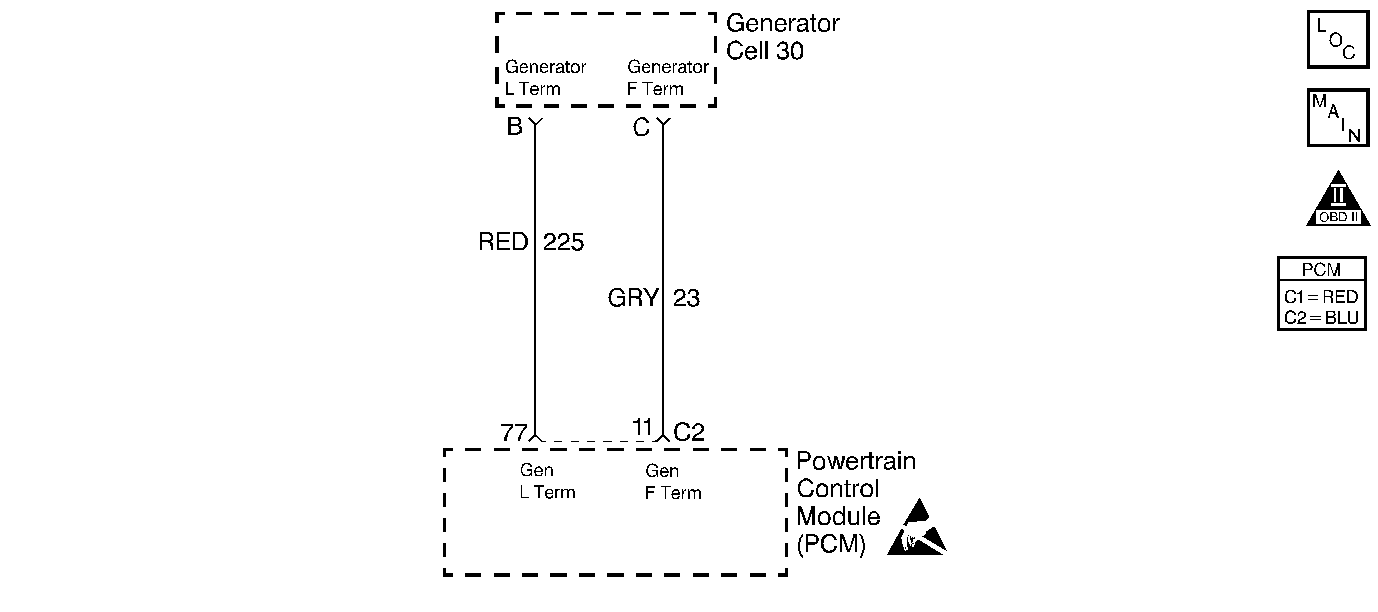
Circuit Description
The L-terminal circuit from the generator is a discrete into the PCM. The PCM supplies the ignition voltage to the generator lamp feed. This ignition voltage is pulled low by the generator once the ignition switch supplies ignition 1 voltage. The voltage stays low until the generator turns. When the generator is up and running, the PCM detects ignition voltage. Therefore, with no failures with the vehicle's charging system, the lamp terminal circuit will go low (0 volts) when the ignition switch is powered up and then goes to the ignition voltage after the engine is started.
The F-terminal circuit from the generator is a pulse width modulation (PWM) signal to the PCM. The PCM detects the PWM frequency by sampling the average voltage at the F-terminal of the generator. When the ignition switch supplies ignition 1 voltage, the generator goes to a predetermined duty cycle. When the generator is up and running, the generator regulator starts regulating and suppling the current. Therefore, with no failures with the vehicle's charging system, the field terminal circuit voltage will be at a low value and stay there until roughly 0.5 second after the engine idles. When the engine is idles, the voltage transitions to a higher value.
When the charging system detects a fault (circuit shorted to ground), the Driver Information Center will display Charging System Fault.
Diagnostic Aids
A generator fault, such as a shorted output diode, malfunctioning regulator, open or shorted rotor, or open sense lead may cause a low battery charge. Refer to Engine/Engine Electrical for further information and generator diagnosis.
Use a scan tool in order to diagnosis the generator circuits. A scan tool displays Generator L-Terminal Inactive when there is a problem with the L-terminal circuit.
Test Description
The numbers below refer to the step numbers on the Diagnostic Table.
Step | Action | Value(s) | Yes | No |
|---|---|---|---|---|
1 | Did you perform the Powertrain On-Board Diagnostic (OBD) System Check? | -- | ||
Does the scan tool display Generator F terminal 0 or 188 counts and/or the Generator L terminal display Inactive? | -- | Go toDiagnostic Aids | ||
3 | Probe the Generator battery feed circuit using a Test Lamp connected to ground. Does the test lamp illuminate? | -- | Go to Engine Electrical for further diagnosis. | |
4 |
Does the test lamp illuminate? | -- | Go to Engine Electrical for further diagnosis. | |
5 |
Is the voltage the same or more than the value specified? | 10V | ||
6 |
Did the Generator F terminal parameter change from 0 to 188? | -- | ||
7 |
Does the DMM indicate continuity? | -- | ||
8 | Check continuity from terminal C at the generator harness connector to battery ground using the DMM J 39200 . Does the DMM indicate continuity? | -- | ||
9 |
Does the DMM indicate continuity? | -- | ||
10 | Check continuity from terminal B at the generator harness connector to battery ground using the DMM J 39200 . Does the DMM indicate continuity? | -- | ||
11 | Repair the short to ground in the generator circuit. Is the repair complete? | -- | System OK | -- |
12 | Repair the open/high resistance in the generator circuit. Is the repair complete? | -- | System OK | -- |
13 | Check the terminal contact at the PCM harness connector. Did you find and correct the condition? | -- | System OK | |
14 |
Important: Program the replacement PCM. Refer to Powertrain Control Module/Throttle Actuator Control Module Replacement . Replace the PCM. Is the action complete? | -- | System OK | -- |
Did you find and correct the condition? | -- | System OK | ||
16 | Repair or replace the generator. Refer to Engine/Engine Electrical. Is the action complete? | -- | System OK | -- |
